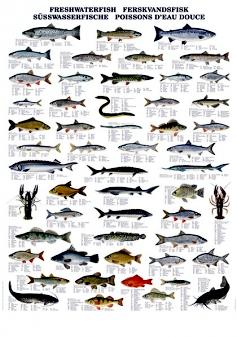Fish have been on Earth for over 500 million years, long before even the dinosaurs roamed the planet. There are over 25,000 species of fish which is more than all the species of amphibians, reptiles, birds and mammals combined and are divided into 3 main groups. They are the jawless, the cartilaginous (KAR-ti-LAJ-i-nus) and the bony fish. Jawless fish are the last survivors of the world’s first vertebrate (VUR-ta-bret) animals, which means “back-boned”. They lack both scales and jaws. Dating from over 500 million years ago, only the Hagfish and Lamprey Eels remain. Cartilaginous fish developed about 100 million years later, ancestors of today’s sharks. The skeleton of these fish is made of cartilage (KART-laj), which is not as hard as bone. These fish have jaws, as well as teeth which are usually hard and sharp. Their bodies are covered with hard scales. Bony fish—fish with bony skeletons—appeared at the same time as cartilaginous fish. They are the largest group, with about 20,000 species. These fish have an organ called a swim bladder which gives the animal buoyancy (BOY en-see), the ability to float. All fish live in water and breathe with gills. Fish are cold-blooded, which means their internal body temperature changes as the surrounding temperature changes.
all the species of amphibians, reptiles, birds and mammals combined and are divided into 3 main groups. They are the jawless, the cartilaginous (KAR-ti-LAJ-i-nus) and the bony fish. Jawless fish are the last survivors of the world’s first vertebrate (VUR-ta-bret) animals, which means “back-boned”. They lack both scales and jaws. Dating from over 500 million years ago, only the Hagfish and Lamprey Eels remain. Cartilaginous fish developed about 100 million years later, ancestors of today’s sharks. The skeleton of these fish is made of cartilage (KART-laj), which is not as hard as bone. These fish have jaws, as well as teeth which are usually hard and sharp. Their bodies are covered with hard scales. Bony fish—fish with bony skeletons—appeared at the same time as cartilaginous fish. They are the largest group, with about 20,000 species. These fish have an organ called a swim bladder which gives the animal buoyancy (BOY en-see), the ability to float. All fish live in water and breathe with gills. Fish are cold-blooded, which means their internal body temperature changes as the surrounding temperature changes. 
Some Interesting Facts
- Fish have been on the earth for more than 450 million years.
- Fish were well established long before dinosaurs roamed the earth.
- There are over 25,000 identified species of fish on the earth.
- It is estimated that there may still be over 15,000 fish species that have not yet been identified.
- There are more species of fish than all the species of amphibians, reptiles, birds and mammals combined.
- 40% of all fish species inhabit freshwater, yet less than .01% of the earth’s water is freshwater.
- Some fish are able to absorb oxygen from the air and crawl overland using strong pectoral fins.
- Some fish don’t posses an air bladder to help keep them afloat and must either swim continually or rest on the bottom.
- Some fish make sounds by grating their teeth and others make sounds from their air filled swim bladder.
- Some species of fish can fly (glide), others can skip along the surface and others can even climb rock.
- Fish have a specialized sense organ called the lateral line which works much like radar and helps them navigate in dark or murky water.
- The largest fish is the Whale Shark which can reach 50 feet in length.
- 91% of tropical fish sold in the United States are harvested from the wild in Africa, Asia, Central & South America.
- Some species of fish have skeletons made only of cartilage.
- Fish have excellent senses of sight, touch, taste and many possess a good sense of smell & hearing.
- Fish feel pain and suffer stress just like mammals and birds.
- Tropical fish are one of the most popular pets in the U.S.
- 95% of tropical fish mortality results from improper housing and nutrition.
- The world’s smallest fish
 is the Paideios (“Paedocypris progenetica”) from Indonesia, with mature females measuring 7.9 millimeters (0.31 inches). A member of the carp family, it has a translucent body and a head unprotected by a skeleton.
is the Paideios (“Paedocypris progenetica”) from Indonesia, with mature females measuring 7.9 millimeters (0.31 inches). A member of the carp family, it has a translucent body and a head unprotected by a skeleton.